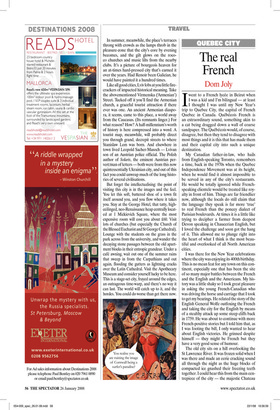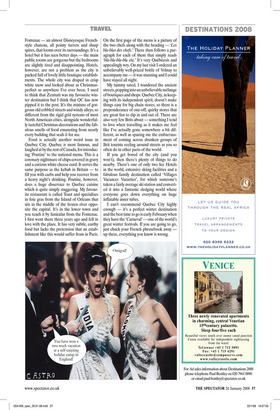The real French
Dom Joly
Iwent to a French lycée in Beirut when I was a kid and I’m bilingual — at least I thought I was until my New Year’s trip to Quebec City, the capital of French Quebec in Canada. Québécois French is an extraordinary sound, something akin to a cat being dragged down a wall of coarse sandpaper. The Québécois would, of course, disagree, but then they tend to disagree with most things and it is this that has made them and their capital city into such a unique destination.
My Canadian father-in-law, who hails from English-speaking Toronto, remembers a time, back in the 1970s when the Quebec Independence Movement was at its height, when he would find it almost impossible to be served in any of the city’s restaurants. He would be totally ignored while Frenchspeaking clientele would be treated like royalty in front of him. Things are far friendlier now, although the locals do still claim that the language they speak is far more ‘true’ to real French than the poncey dialect of Parisian boulevards. At times it is a little like trying to decipher a farmer from deepest Devon speaking in Chaucerian English, but I loved the challenge and soon got the hang of it. This allowed me to plunge right into the heart of what I think is the most beautiful and overlooked of all North American cities.
I was there for the New Year celebrations where the city was enjoying its 400th birthday. This is no mean feat for any town on this continent, especially one that has been the site of so many major battles between the French and the English and the Americans. My history was a little shaky so I took great pleasure in asking the young French-Canadian who was driving the horse and carriage that I took to get my bearings. He related the story of the English General Wolfe outfoxing the French and taking the city for the English by means of a stealthy attack up some steep cliffs back in 1759. He was about to continue with more French-positive stories but I told him that, as I was footing the bill, I only wanted to hear about English victories. He grinned despite himself — they might be French but they have a very good sense of humour.
The old city sits on a hill overlooking the St Lawrence River. It was frozen solid when I was there and made an eerie cracking sound all through the night as the huge blocks of compacted ice gnashed their freezing teeth together. I could hear this from the main centrepiece of the city — the majestic Chateau Fontenac — an almost Disneyesque Frenchstyle chateau, all pointy turrets and sharp spires, that looms over its surroundings. It’s a hotel but it has seen better days — the main public rooms are gorgeous but the bedrooms are slightly tired and disappointing. Hotels, however, are not a problem as the city is packed full of lovely little boutique establishments. The whole city was draped in crisp white snow and looked about as Christmasperfect as anywhere I’ve ever been. I used to think that Zermatt was my favourite winter destination but I think that QC has now pipped it to the post. It’s the mixture of gorgeous old cobbled streets and windy alleys, so different from the rigid grid systems of most North American cities, alongside wonderfully tasteful Christmas decorations and the fabulous smells of food emanating from nearly every building that seals it for me.
Food is actually another weird issue in Quebec City. Quebec is most famous, and laughed at by the rest of Canada, for introducing ‘Poutine’ to the national menu. This is a coronary nightmare of chips covered in gravy and a curious white cheese curd. It serves the same purpose as the kebab in Britain — to fill you with carbs and help you recover from a heavy night’s drinking. Poutine, however, does a huge disservice to Quebec cuisine which is quite simply staggering. My favourite restaurant is called Toast and specialises in foie gras from the Island of Orleans that sits in the middle of the frozen river opposite the capital. It’s in the lower town and you reach it by funicular from the Fontenac. I first went there three years ago and fell in love with the place. It has very subtle, earthy food but lacks the pretension that an establishment like this would suffer from in Paris. On the first page of the menu is a picture of the two chefs along with the heading — ‘Les bla-blas des chefs.’ There then follows a paragraph for each of them that simply reads ‘bla-bla-bla-bla etc.’ It’s very Québécois and appealingly wry. On my last visit I ordered an unbelievably well-priced bottle of Volnay to accompany me — it was stunning and I could have stayed all night.
My tummy sated, I wandered the ancient streets, popping into an unbelievable mélange of boutiques and shops. Quebec City, in keeping with its independent spirit, doesn’t make things easy for big chain stores, so there is a preponderance of one-off, quirky stores that are great fun to dip in and out of. There are also very few Brits about — something I tend to love when travelling as it makes me feel like I’ve actually gone somewhere a bit different, as well as sparing me the embarrassment of coming across drunken groups of Brit tourists reeling around streets as you so often do in other parts of the world.
If you get bored of the city (and you won’t), then there’s plenty of things to do nearby. There’s one of only two Ice Hotels in the world, extensive skiing facilities and a fabulous family destination called ‘Villages Vacances Vacartier’, for which someone’s taken a fairly average ski station and converted it into a fantastic sledging world where everyone goes down everything on huge inflatable inner tubes.
I can’t recommend Quebec City highly enough — it’s a perfect winter destination and the best time to go is early February when they have the ‘Carneval’ — one of the world’s great winter festivals. If you are going to go, just chuck your French phrasebook away — up there, everything you know is wrong.











































































 Previous page
Previous page